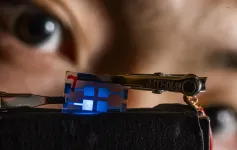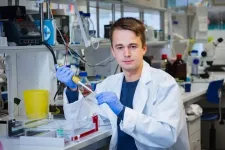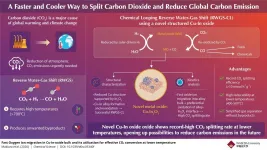A 'ghastly future' unless extraordinary action is taken soon on sustainability
Global team of scientists, including UCLA's Daniel Blumstein, points to environmental, population and political challenges
2021-01-13
(Press-News.org) Without immediate and drastic intervention, humans face a "ghastly future" -- including declining health, climate devastation, tens of millions of environmental migrants and more pandemics -- in the next several decades, according to an international team of 17 prominent scientists.
ELSE PRESS RELEASES FROM THIS DATE:
Blue-light stride in perovskite-based LEDs
2021-01-13
Researchers at Linköping University, Sweden, have developed efficient blue light-emitting diodes based on halide perovskites. "We are very excited about this breakthrough", says Feng Gao, professor at Linköping University. The new LEDs may open the way to cheap and energy-efficient illumination.
Illumination is responsible for approximately 20% of global electricity consumption, a figure that could be reduced to 5% if all light sources consisted of light-emitting diodes (LEDs). The blue-white LEDs currently in use, however, need complicated manufacturing methods and are expensive, which makes it more difficult to achieve ...
Limits of atomic nuclei predicted
2021-01-13
Atomic nuclei are held together by the strong interaction between neutrons and protons. About ten percent of all known nuclei are stable. Starting from these stable isotopes, nuclei become increasingly unstable as neutrons are added or removed, until neutrons can no longer bind to the nucleus and "drip" out. This limit of existence, the so-called neutron "dripline", has so far been discovered experimentally only for light elements up to neon. Understanding the neutron dripline and the structure of neutron-rich nuclei also plays a key role in the research program for the future accelerator facility FAIR at the GSI Helmholtz Centre for Heavy Ion Research in Darmstadt.
In a new study, "Ab Initio Limits of Nuclei," ...
A new study identifies possible biomarkers of severe malaria in African children
2021-01-13
The levels of small molecules called microRNAs (miRNAs) circulating in blood could help identify early on children with life-threatening forms of malaria, according to a study led by the Barcelona Institute for Global Health, an institution supported by "la Caixa" Foundation, in collaboration with the Manhiça Health Research Center (CISM) in Mozambique. The results, published in Emerging Infectious Diseases journal, could also help better understand the mechanisms underlying severe malaria.
Malaria mortality among young African children remains unacceptably high. To improve the outcome, it is important to rapidly identify and treat children with severe forms of the disease. ...
Seawater as an electrical cable !? Wireless power transfers in the ocean
2021-01-13
Overview:
Associate professor Masaya Tamura, Kousuke Murai (who has completed the first term of his master's program), and their research team from the Department of Electrical and Electronic Information Engineering at Toyohashi University of Technology have successfully transferred power and data wirelessly through seawater by using a power transmitter/receiver with four layers of ultra-thin, flat electrodes. In the field of wireless power transfers, seawater behaves as a dielectric with extremely high loss, and achievement through capacitive coupling is difficult. Up until now, it had been thought that wireless power transfers could only be achieved through magnetic coupling. ...
New molecular structures associated with ALS
2021-01-13
Researchers from the University of Seville and the University of Pavia have identified a link between Amyotrophic Lateral Sclerosis (ALS) and the accumulation of DNA-RNA hybrids in the genome. The accumulation of these hybrids causes increased genomic damage and boosts genetic instability. This finding will make it possible to better understand the molecular basis of the disease, as well as to propose new solutions to curb it.
Amyotrophic Lateral Sclerosis (ALS) is a neurodegenerative disease of the central nervous system, characterised by progressive degeneration ...
Evolution in a test tube: these bacteria survive on deadly copper surfaces
2021-01-13
The descendants of regular wild-type bacteria can evolve to survive for a long time on metallic copper surfaces that would usually kill them within a few minutes. An international research team led by Martin Luther University Halle-Wittenberg (MLU) and the Bundeswehr Institute of Microbiology was able to produce these tiny survivalists in the lab and has been able to study them more closely. The team reports on its findings in Applied and Environmental Microbiology.
Bacterial infections are usually treated with antibiotics. However, in recent decades many pathogenic bacteria have developed an increasing tolerance to common drugs. So-called multidrug-resistant bacteria are of particular concern as ...
How will we achieve carbon-neutral flight in future?
2021-01-13
It is politically agreed and necessary for climate protection reasons that our entire economy becomes climate-neutral in the coming decades - and that applies to air travel, too. This is a technically feasible goal, and there are numerous ways to achieve it. ETH Professor Marco Mazzotti and his team have now compared the options that appear to be the easiest to implement in the short and medium term and evaluated them according to factors such as cost-effectiveness.
The ETH researchers conclude that the most favourable option is to continue powering aircraft with fossil fuels in future, but then remove the associated CO2 emissions from the atmosphere ...
TalTech's neuroscientists investigate the causes of a widespread eye disease
2021-01-13
Fuchs' corneal dystrophy is one of the most common eye diseases diagnosed in almost 5% of the population of Europe aged 40 years or over. It is a hereditary eye disease that causes vision impairment and typically manifests in middle age. The first symptoms of the disease - blisters on the surface of your cornea - resemble cataract at first glance. The disease progresses from the centre of the cornea affecting all layers of the cornea. The progression of the disease varies from individual to individual and in severe cases results in vision loss.
The molecular neurobiology ...
Copper-indium oxide: A faster and cooler way to reduce our carbon footprint
2021-01-13
With ever-worsening climate change, there is a growing need for technologies that can capture and use up the atmospheric CO2 (carbon dioxide) and reduce our carbon footprint. Within the realm of renewable energy, CO2-based e-fuels have emerged as a promising technology that attempts to convert atmospheric CO2 into clean fuels. The process involves production of synthetic gas or syngas (a mixture of hydrogen and carbon monoxide (CO)). With the help of the reverse water-gas shift (RWGS) reaction, CO2 is broken down into the CO necessary for syngas. While promising in its conversion efficiency, the RWGS reaction requires incredibly high temperatures (>700°C) to proceed, while also generating ...
Lipid biomarkers in urine can determine the type of asthma
2021-01-13
In a new study, researchers at Karolinska Institutet in Sweden have used a urine test to identify and verify a patient's type of asthma. The study, which has been published in the American Journal of Respiratory and Critical Care Medicine, lays the foundation for a more personalized diagnosis and may result in improved treatment of severe asthma in the future.
About 10 percent of the Swedish population suffers from asthma, a disease that has become increasingly widespread over the past 50 years, with annual global mortality of around 400,000 according to the World Health Organization. Asthma is characterized by chronic inflammation in the airways, which can result in symptoms including ...
LAST 30 PRESS RELEASES:
SIMJ announces global collaborative book project in commemoration of its 75th anniversary
Air pollution exposure and birth weight
Obstructive sleep apnea risk and mental health conditions among older adults
How talking slows eye movements behind the wheel
The Ceramic Society of Japan’s Oxoate Ceramics Research Association launches new international book project
Heart-brain connection: international study reveals the role of the vagus nerve in keeping the heart young
Researchers identify Rb1 as a predictive biomarker for a new therapeutic strategy in some breast cancers
Survey reveals ethical gaps slowing AI adoption in pediatric surgery
Stimulant ADHD medications work differently than thought
AI overestimates how smart people are, according to HSE economists
HSE researchers create genome-wide map of quadruplexes
Scientists boost cell "powerhouses" to burn more calories
Automatic label checking: The missing step in making reliable medical AI
Low daily alcohol intake linked to 50% heightened mouth cancer risk in India
American Meteorological Society announces Rick Spinrad as 2026 President-Elect
Biomass-based carbon capture spotlighted in newly released global climate webinar recording
Illuminating invisible nano pollutants: advanced bioimaging tracks the full journey of emerging nanoscale contaminants in living systems
How does age affect recovery from spinal cord injury?
Novel AI tool offers prognosis for patients with head and neck cancer
Fathers’ microplastic exposure tied to their children’s metabolic problems
Research validates laboratory model for studying high-grade serous ovarian cancer
SIR 2026 delivers transformative breakthroughs in minimally invasive medicine to improve patient care
Stem Cell Reports most downloaded papers of 2025 highlight the breadth and impact of stem cell research
Oxford-led study estimates NHS spends around 3% of its primary and secondary care budget on the health impacts of heat and cold in England
A researcher’s long quest leads to a smart composite breakthrough
Urban wild bees act as “microbial sensors” of city health.
New study finds where you live affects recovery after a hip fracture
Forecasting the impact of fully automated vehicle adoption on US road traffic injuries
Alcohol-related hospitalizations from 2016 to 2022
Semaglutide and hospitalizations in patients with obesity and established cardiovascular disease
[Press-News.org] A 'ghastly future' unless extraordinary action is taken soon on sustainabilityGlobal team of scientists, including UCLA's Daniel Blumstein, points to environmental, population and political challenges




